light Lexus HS250h 2011 Do-it-yourself maintenance / LEXUS 2011 HS250H (OM75037U) User Guide
[x] Cancel search | Manufacturer: LEXUS, Model Year: 2011, Model line: HS250h, Model: Lexus HS250h 2011Pages: 628, PDF Size: 10.69 MB
Page 30 of 628

30
1-1. Hybrid system
■If a warning light comes on, a warning message is displayed, or the 12-volt battery
is disconnected
The hybrid system may not start. In that case, try to start the system again. If the
“READY” indicator does not come on, contact your Lexus dealer.
■Electromagnetic waves
●High voltage parts and cables on the hybrid vehicles incorporate electromag-
netic shielding, and theref ore emit approximately the same amount of electro-
magnetic waves as conventional gasoline powered vehicles or home electronic
appliances.
●Your vehicle may cause sound interference in some third party-produced radio
parts.
■Running out of fuel
When the vehicle has run out of fuel and th e hybrid system cannot be started, refuel
the vehicle with at least enough gasoline to make the low fuel level warning light
( P. 501) go off. If there is only a small amount of fuel, the hybrid system may not
be able to start. (The minimum amount of fuel to add to make the low fuel level
warning light go out is about 2.6 gal. [10 L, 2.1 Imp.gal.], when the vehicle is on a
level surface. This value may vary when the vehicle is on a slope.)
■Hybrid battery (traction battery)
The hybrid battery (traction battery) has a limited service life. The lifespan of the
hybrid battery (traction battery) can chan ge in accordance with driving style and
driving conditions.
Page 35 of 628
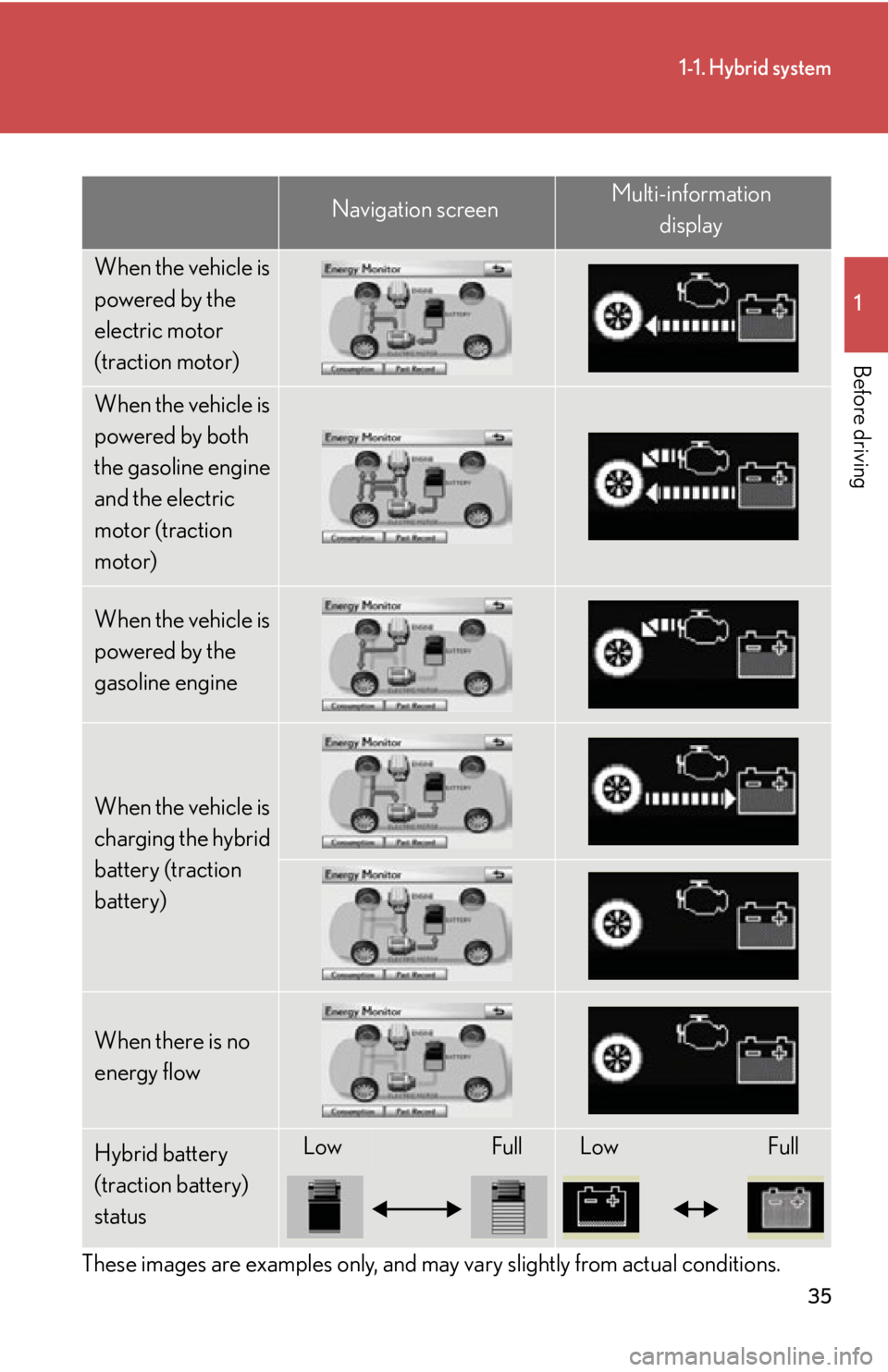
35
1-1. Hybrid system
1
Before driving
These images are examples only, and may vary slightly from actual conditions.
Navigation screenMulti-information display
When the vehicle is
powered by the
electric motor
(traction motor)
When the vehicle is
powered by both
the gasoline engine
and the electric
motor (traction
motor)
When the vehicle is
powered by the
gasoline engine
When the vehicle is
charging the hybrid
battery (traction
battery)
When there is no
energy flow
Hybrid battery
(traction battery)
statusLowFullLowFull
Page 37 of 628
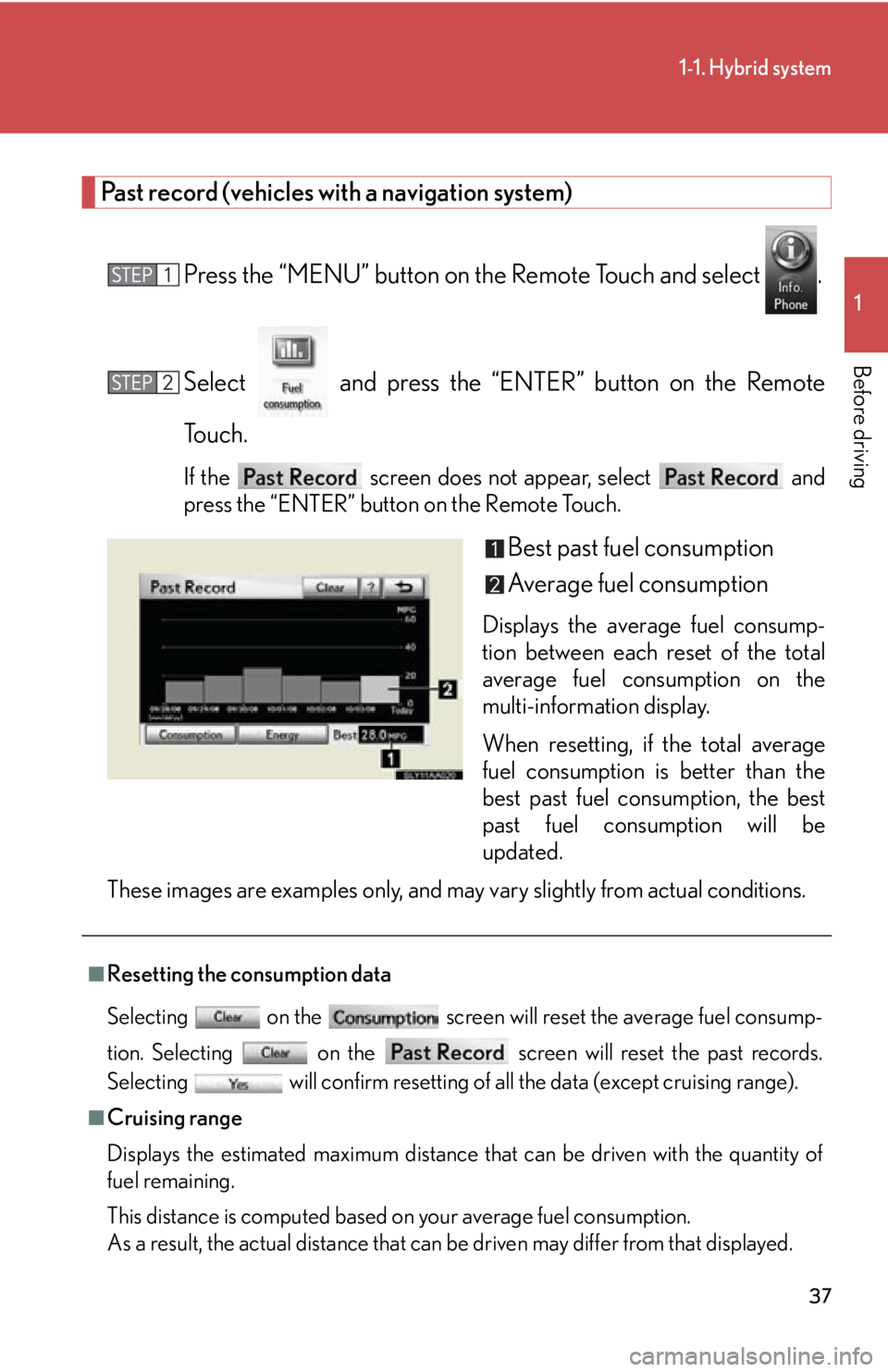
37
1-1. Hybrid system
1
Before driving
Past record (vehicles with a navigation system)Press the “MENU” button on the Remote Touch and select .
Select and press the “ENTER” button on the Remote
To u c h .
If the screen does not appear, select and
press the “ENTER” button on the Remote Touch.
Best past fuel consumption
Average fuel consumption
Displays the average fuel consump-
tion between each reset of the total
average fuel consumption on the
multi-information display.
When resetting, if the total average
fuel consumption is better than the
best past fuel consumption, the best
past fuel consumption will be
updated.
These images are examples only, and may vary slightly from actual conditions.
■Resetting the consumption data
Selecting on the screen will reset the average fuel consump-
tion. Selecting on the screen will reset the past records.
Selecting will confirm resetting of all the data (except cruising range).
■Cruising range
Displays the estimated maximum distance th at can be driven with the quantity of
fuel remaining.
This distance is computed based on your average fuel consumption.
As a result, the actual distance that can be driven may differ from that displayed.
Page 38 of 628
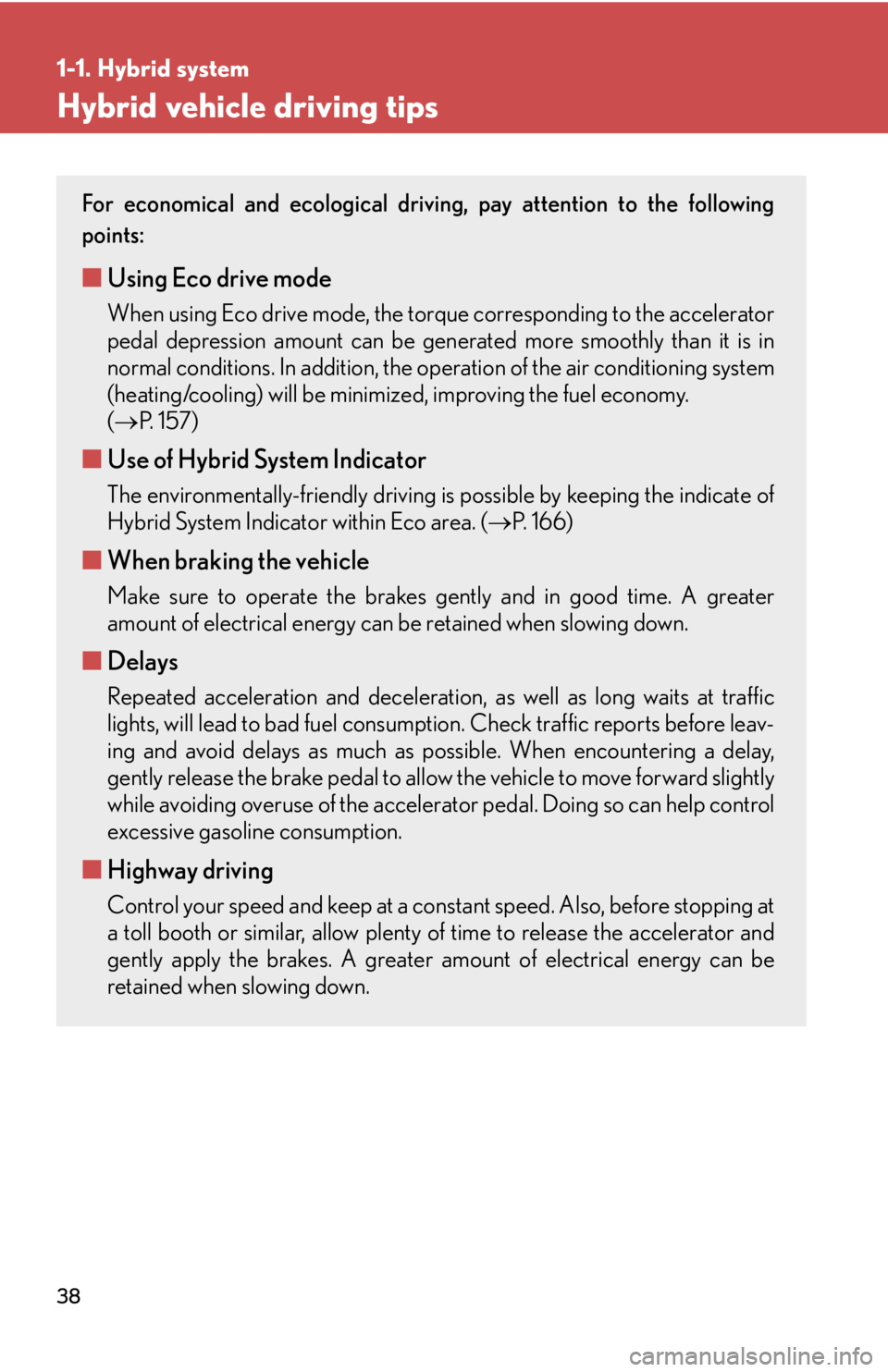
38
1-1. Hybrid system
Hybrid vehicle driving tips
For economical and ecological driving, pay attention to the following
points:
■Using Eco drive mode
When using Eco drive mode, the torq ue corresponding to the accelerator
pedal depression amount can be generated more smoothly than it is in
normal conditions. In addition, the op eration of the air conditioning system
(heating/cooling) will be minimized, improving the fuel economy.
( P. 1 5 7 )
■Use of Hybrid System Indicator
The environmentally-friendly driving is possible by keeping the indicate of
Hybrid System Indicator within Eco area. ( P. 1 6 6 )
■When braking the vehicle
Make sure to operate the brakes ge ntly and in good time. A greater
amount of electrical energy can be retained when slowing down.
■ Delays
Repeated acceleration and deceleration, as well as long waits at traffic
lights, will lead to bad fu el consumption. Check traffic reports before leav-
ing and avoid delays as much as possible. When encountering a delay,
gently release the brake pedal to allow the vehicle to move forward slightly
while avoiding overuse of the accelerato r pedal. Doing so can help control
excessive gasoline consumption.
■ Highway driving
Control your speed and keep at a constant speed. Also, before stopping at
a toll booth or similar, allow plenty of time to release the accelerator and
gently apply the brakes. A greater amount of electrical energy can be
retained when slowing down.
Page 44 of 628

44
1-2. Key information
NOTICE
■Precautions for handling the card key
●Do not apply excess force when inserting the mechanical key into the card key.
Doing so may damage the card key.
●If the battery or card key terminals get wet, the battery may corrode and the card
key may stop working.
If the key is dropped into water, or if drinking water etc. is spilled on the key,
immediately remove the battery cover and wipe the battery and terminals. (To
remove the battery cover, lightly grasp and pull it.) If the battery is corroded, have
your Lexus dealer replace the battery.
●Do not crush the battery cover or use a screwdriver to remove the battery cover.
Forcibly removing the battery co ver may bend or damage the key.
●If the battery cover is frequently removed, the battery cover may become loose.
●When installing the battery, make sure to check the direction of the battery.
Installing the battery in the wrong direction may cause the battery to deplete rap-
idly.
●The surface of the card key may be damage d, or its coating may peel off in the
following situations:
• The card key is carried together with hard objects, such as coins and keys.
• The card key is scraped with a sharp object, such as the tip of a mechanical
pencil.
• The surface of the card key is wiped with thinner or benzene.
Page 52 of 628

52
1-3. Opening, closing and locking the doors
●If the electronic key is inside the vehicle and a door handle becomes wet during
a car wash, a message may be shown on the multi-information display and a
buzzer will sound outside the vehicle. To turn off the alarm, lock all the doors.
●The lock sensor may not work properly if it comes into contact with ice, snow,
mud, etc. Clean the lock sensor and attempt to operate it again, or use the lock
sensor on the lower part of the door handle.
●Fingernails may scrape against the door during operation of the door handle.
Be careful not to injure fingernails or damage the surface of the door.
■Notes for the unlocking function
●A sudden approach to the effective range or door handle may prevent the
doors from being unlocked. In this case, return the door handle to the original
position and check that the doors unlock before pulling the door handle again.
●Gripping the door handle when wearing a glove may not unlock the door.
Remove the gloves and touch the sensor on the back of the handle again.
●If the door handle becomes wet while the electronic key is within the effective
range, the door may lock and unlock repeatedly. Place the key in a position 6 ft.
(2 m) or more separate from the vehicle while the vehicle is being washed. (Take
care to ensure that the key is not stolen.)
●If there is another electronic key in the detection area, it may take slightly longer
to unlock the doors after the door handle is gripped.
●Fingernails may scrape against the door during operation of the door handle.
Be careful not to injure fingernails or damage the surface of the door.
■When the vehicle is not driven for extended periods
●To prevent theft of the vehicle, do not le ave the electronic key within 6 ft. (2 m)
of the vehicle.
●The smart access system with push-butto n start can be deactivated in advance.
( P. 580)
■Alarm
Using the smart access system with push-bu tton start to lock the doors will set the
alarm system. ( P. 1 0 0 )
■To operate the system properly
Make sure to carry the electronic key wh en operating the system. Do not get the
electronic key too close to the vehicle when operating the system from the outside
of the vehicle.
Page 56 of 628
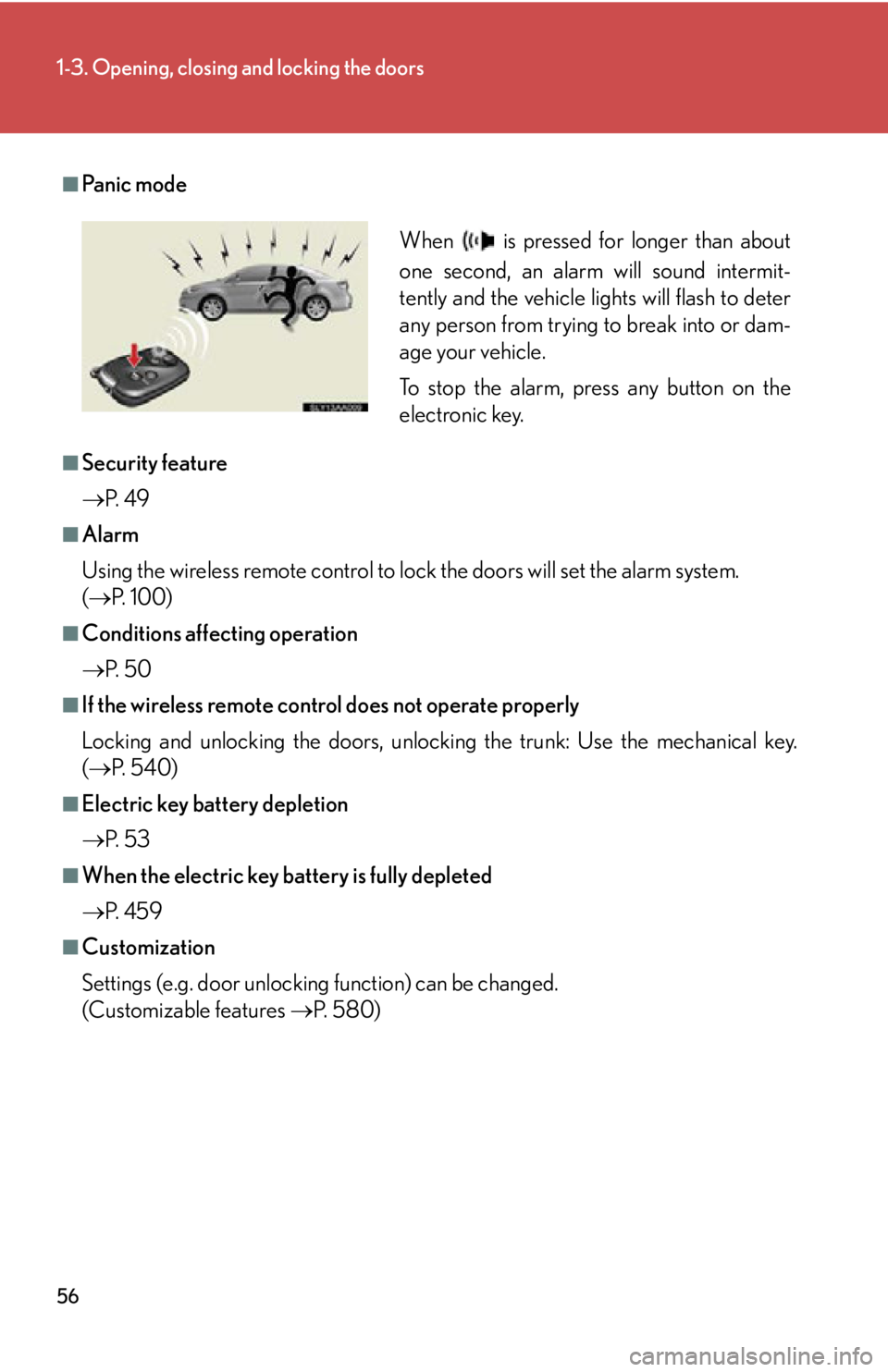
56
1-3. Opening, closing and locking the doors
■Pa n i c m o d e
■Security feature
P. 4 9
■Alarm
Using the wireless remote control to lock the doors will set the alarm system.
( P. 100)
■Conditions affecting operation
P. 5 0
■If the wireless remote control does not operate properly
Locking and unlocking the doors, unlocking the trunk: Use the mechanical key.
( P. 5 4 0 )
■Electric key battery depletion
P. 5 3
■When the electric key battery is fully depleted
P. 4 5 9
■Customization
Settings (e.g. door unlocking function) can be changed.
(Customizable features P. 5 8 0 )
When is pressed for longer than about
one second, an alarm will sound intermit-
tently and the vehicle lights will flash to deter
any person from trying to break into or dam-
age your vehicle.
To stop the alarm, press any button on the
electronic key.
Page 64 of 628
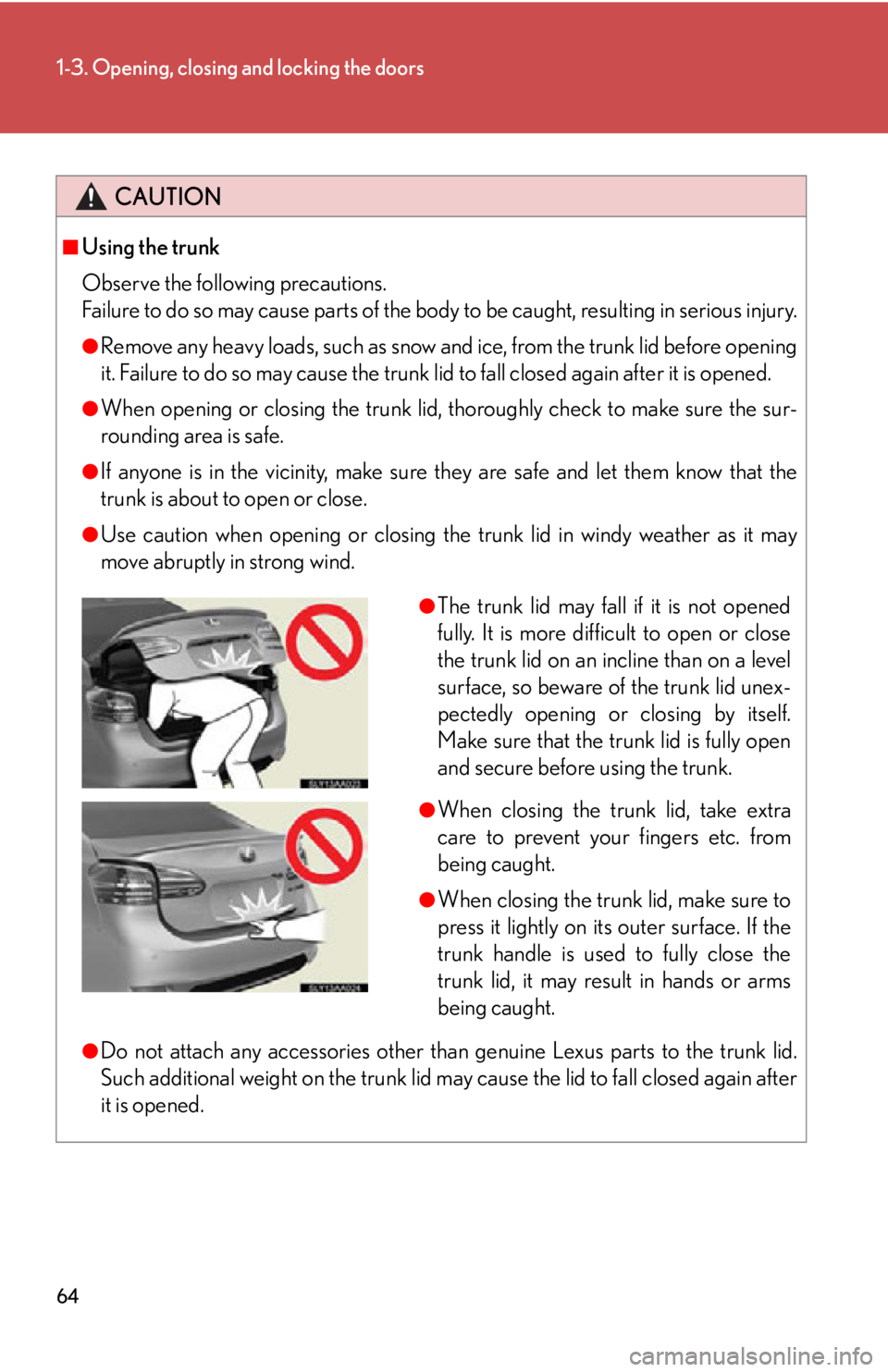
64
1-3. Opening, closing and locking the doors
CAUTION
■Using the trunk
Observe the following precautions.
Failure to do so may cause parts of the body to be caught, resulting in serious injury.
●Remove any heavy loads, such as snow and ice, from the trunk lid before opening
it. Failure to do so may cause the trunk lid to fall closed again after it is opened.
●When opening or closing the trunk lid, thoroughly check to make sure the sur-
rounding area is safe.
●If anyone is in the vicinity, make sure they are safe and let them know that the
trunk is about to open or close.
●Use caution when opening or closing the trunk lid in windy weather as it may
move abruptly in strong wind.
●Do not attach any accessories other than genuine Lexus parts to the trunk lid.
Such additional weight on the trunk lid may cause the lid to fall closed again after
it is opened.
●The trunk lid may fall if it is not opened
fully. It is more difficult to open or close
the trunk lid on an incline than on a level
surface, so beware of the trunk lid unex-
pectedly opening or closing by itself.
Make sure that the trunk lid is fully open
and secure before using the trunk.
●When closing the trunk lid, take extra
care to prevent your fingers etc. from
being caught.
●When closing the trunk lid, make sure to
press it lightly on its outer surface. If the
trunk handle is used to fully close the
trunk lid, it may result in hands or arms
being caught.
Page 67 of 628
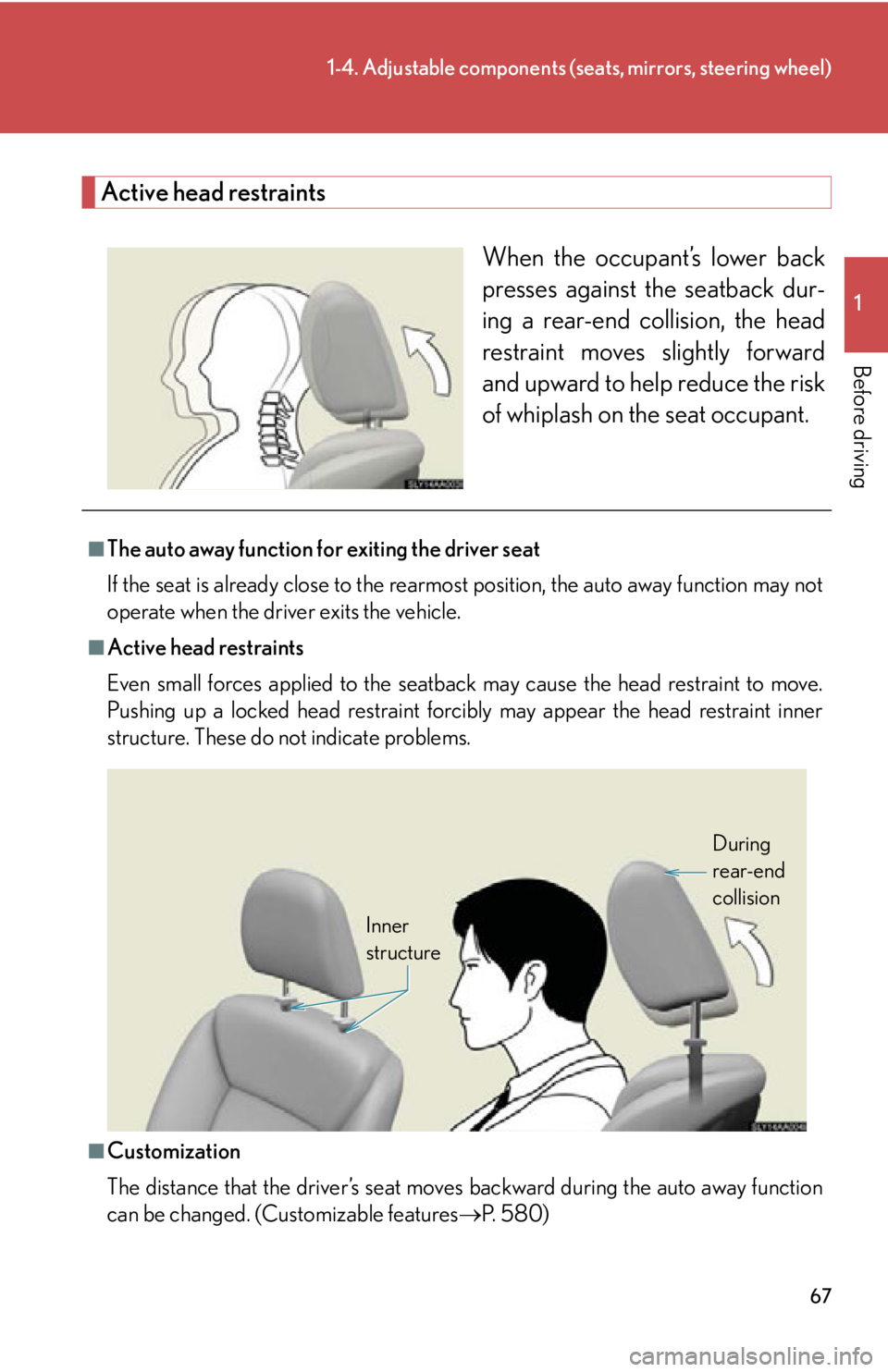
67
1-4. Adjustable components (seats, mirrors, steering wheel)
1
Before driving
Active head restraintsWhen the occupant’s lower back
presses against the seatback dur-
ing a rear-end collision, the head
restraint moves slightly forward
and upward to help reduce the risk
of whiplash on the seat occupant.
■The auto away function for exiting the driver seat
If the seat is already close to the rearmost position, the auto away function may not
operate when the driver exits the vehicle.
■Active head restraints
Even small forces applied to the seatback may cause the head restraint to move.
Pushing up a locked head restraint forcibly may appear the head restraint inner
structure. These do not indicate problems.
■Customization
The distance that the driver’s seat move s backward during the auto away function
can be changed. (Customizable features P. 5 8 0 )
Inner
structure During
rear-end
collision
Page 76 of 628

76
1-4. Adjustable components (seats, mirrors, steering wheel)
■Emergency locking retractor (ELR)
The retractor will lock the belt during a sudd en stop or on impact. It may also lock if
you lean forward too quickly. A slow, easy motion will allow the belt to extend so that
you can move around fully.
■Automatic locking retractor (ALR)
When a passenger’s shoulder belt is completely extended and then retracted even
slightly, the belt is locked in that position and cannot be extended. This feature is
used to hold the child restraint system (CRS) firmly. To free the belt again, fully
retract the belt and then pull the belt out once more. ( P. 1 2 7 )
■Pregnant women
■People suffering illness
Obtain medical advice and wear the seat belt in the proper way. ( P. 74 )
■Child seat belt usage
The seat belts of your vehicle were princi pally designed for persons of adult size.
●Use a child restraint system appropriate for the child, until the child becomes
large enough to properly wear the vehicle’s seat belt. ( P. 1 2 3 )
●When the child becomes large enough to properly wear the vehicle’s seat belt,
follow the instructions on P. 74 regarding seat belt usage.
Obtain medical advice and wear the seat belt
in the proper way. ( P. 74 )
Women who are pregnant should position
the lap belt as low as possible over the hips in
the same manner as other occupants. Extend
the shoulder belt completely over the shoul-
der and position the belt across the chest.
Avoid belt contact over the rounding of the
abdominal area.
If the seat belt is not worn properly, not only
the pregnant woman, but also the fetus could
suffer death or serious injury as a result of
sudden braking or a collision.